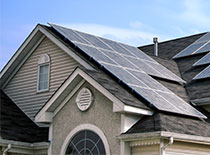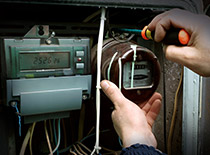Electrical & Lighting Find a Trusted Contractor to Help
A Basic Guide to Your Home’s Electrical Systems
We use our home’s electrical systems all the time, but we rarely sit down to look up how they work. So, here’s a brief guide to the various parts of your electrical system.
Service Wires
Here’s where it all starts; the service wires that go into your home. There are generally three service wires, carrying voltage at ranges of 110-120 volts to 220-240 volts. The former power most of your smaller appliances and items; the latter power the bigger stuff, such as your fridge or dryer. These are generally connected to your home fairly high up, but they may also be underground, depending on your utility company or local laws.
Electric Meter
We’ve all seen an electric meter, of course; it’s the big glass-and-steel item bolted to the side of the house. And as you’re probably aware, it measures the amount and rate that electricity flows into your home. No, you can’t just monkey with it: If a repair or problem somehow involves your electric meter, you should call your utility company ASAP. From there, the electricity flows into…
The Main Service Panel
Generally located inside your home, usually in the basement or in another accessible location, the main service panel is also sometimes called the fusebox or the circuit breaker. Generally, if the power goes out in your home, and it’s not due to terrible weather or damage to power lines, the problem is originating here. Inside the service panel you’ll find…
Circuit Breakers
A circuit breaker is a safety feature that you find in many modern service panels; it’s made up of the black switches you see when you open up the panel. Generally, the circuit breaker will “trip” when it detects an unsafe surge or load on the system. If you keep flipping a circuit breaker, it’s a sign that you’re putting too much load onto a specific circuit in your home’s system.
The circuit breaker works by being wired into the circuit; inside is a small electromagnet, powered by the current flowing through. The more power you pull through the circuit, the stronger the electromagnet gets; if it gets too high, it pulls down a metal switch, shutting off the circuit. This is designed to protect the devices plugged into the circuit, as well as the user, from surges that may damage appliances, or to stop electricity-related injuries. Circuit breakers generally flip when you have too much plugged into a circuit; if one keeps flipping, unplug some items from the circuit it’s connected to; most circuit breakers are clearly labeled.
Fuses
In older homes, you may find fuses instead. Fuses are just thin wires in a container that complete a circuit; too much load burns out the fuse. Fuses aren’t as safe as circuit breakers, and if you see them, that’s generally a sign a home’s wiring is outdated and may need work.
Outlets
Finally, the current flows through the wires to your standard outlet. Here’s one key fact people should know about outlets: that third prong on the plug isn’t there to annoy you. It’s the ground, and it means a wire runs straight to the earth to prevent you from getting a fatal shock. Some older houses may not have this safety feature, however.
If you need help fixing your electrical system, start with Trusted Home Contractors. Trusted Home Contractors will help you find the right certified electrician for your needs, or any other contractor. Pick the right contractor the right way with Trusted Home Contractors. End






